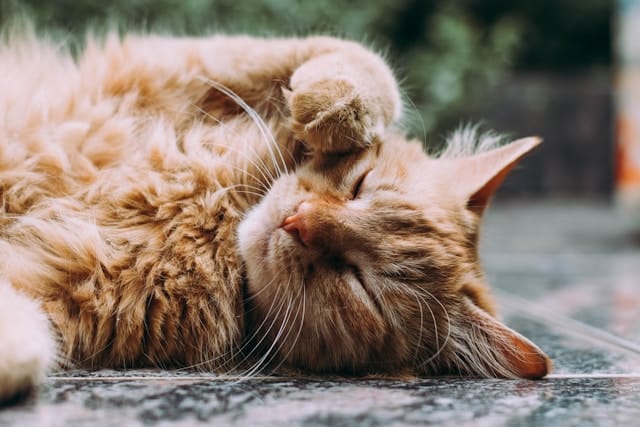Cats, being the meticulous creatures they are, seldom communicate their discomfort directly. When your feline friend encounters issues such as constipation, it can be challenging to discern. However, understanding your pet’s dietary needs can help you address these health concerns effectively. One such crucial nutritional component for cats is dietary fiber. Let’s delve into the intricate role of fiber in a cat’s diet and how it can help manage constipation.
Understanding the Role of Fiber in a Cat’s Diet
Fiber is an essential, though often overlooked, part of your cat’s diet. It’s a type of carbohydrate that remains undigested as it passes through the cat’s digestive system. It helps maintain bowel regularity, control weight, and support overall digestive health. While cats are obligate carnivores and their natural diet in the wild is low in fiber, in a domestic setting, some amount of dietary fiber can be beneficial.
A lire aussi : What Are the Best Pet-Safe Houseplants for a Home with Cats?
Fiber comes in two forms: soluble and insoluble. Soluble fiber attracts water and turns into a gel during digestion, slowing it down. Insoluble fiber, on the other hand, adds bulk to the stool and can help food pass more quickly through the stomach and intestines. Both types can play a role in managing cat constipation.
However, as with all things, balance is key. Too much fiber can lead to nutrient deficiencies and gastrointestinal issues, while too little can result in problems like constipation.
A lire également : What’s the Best Way to Socialize a Puppy with Elderly People and Children?
How Fiber Helps with Cat Constipation
Constipation in cats is a common issue, particularly in older cats. A diet high in fiber can help manage and prevent constipation by adding bulk and moisture to the stool, making it easier for your cat to pass.
Soluble fiber absorbs water and forms a gel-like substance, which can soften the stool and make it more comfortable for your cat to pass. This type of fiber also feeds the good bacteria in your cat’s gut, promoting a healthier digestive system.
On the other hand, insoluble fiber adds bulk to the stool, which can stimulate bowel movements and help alleviate constipation. However, it’s important to remember that while a high-fiber diet can help with constipation, it should be used in combination with other treatments, such as increased hydration and regular exercise.
How to Incorporate High Fiber Foods Into Cat Diets
If your cat has been struggling with constipation, it may be time to take a closer look at their diet. Incorporating food with high fiber content can be beneficial, but it’s essential to do so gradually to avoid upsetting your pet’s stomach.
Canned pumpkin is a commonly recommended high-fiber supplement for cats, but it is vital to use pure pumpkin and not pie filling, which contains added sugars and spices. Other fiber-rich foods that you can incorporate into your cat’s diet include peas, carrots, and certain types of beans.
Remember, it’s not just about adding fiber. It’s also crucial to ensure your cat is drinking enough water, as hydration plays a significant role in preventing constipation. A mix of dry and wet food can help promote better hydration and a more balanced diet.
Choosing the Best High-Fiber Cat Food
When it comes to choosing high-fiber cat food, it’s essential to read the labels and understand what you’re feeding your pet. Look for food that lists a source of animal protein as the first ingredient, followed by a source of fiber. It’s also necessary to note the difference between grain-free and high fiber diets as they are not the same.
Many high-fiber cat foods use grains as a source of fiber, but for cats with grain allergies or sensitivities, grain-free high fiber alternatives are available. Brands such as Blue Buffalo, Royal Canin, and Purina Pro Plan offer high-fiber options specifically designed for digestive health.
Remember, each cat is unique, and what works best for one may not necessarily be the best for another. Therefore, it’s always a good idea to consult with your vet before making significant changes to your cat’s diet.
Comparing Fiber Sources: For Cats and Dogs
While fiber plays a role in both cat and dog diets, it’s important to remember that these two species have different dietary needs and react differently to various types of fiber. Dogs, being omnivores, have a greater capacity to digest plant materials, and therefore can benefit more from certain sources of fiber than cats.
For instance, beet pulp is a common source of fiber in many dog foods, but it can be hard for cats to digest. Likewise, dogs can often tolerate higher levels of fiber in their diets than cats.
When choosing a source of fiber for your cat, it’s essential to keep their specific dietary needs in mind. The goal is to provide a balanced diet that supports your cat’s overall health and wellbeing. With the right amount and type of fiber, you can help alleviate your cat’s constipation and promote a healthier digestive system.
The Role of Fiber in Special Diets for Cats with Specific Conditions
For cats with particular health conditions, the type, amount, and sources of fiber in their diet may require careful consideration. For instance, overweight cats or those with diabetes could benefit from a diet high in insoluble fiber, as it can aid in weight management and maintain stable blood sugar levels.
On the other hand, a diet that includes ample soluble fiber can be useful for cats dealing with gastrointestinal issues such as diarrhea or Irritable Bowel Syndrome (IBS). The gel-like substance formed by soluble fiber during digestion can help normalize bowel movements by adding consistency to the stool. Moreover, soluble fiber serves as food for beneficial gut bacteria, thereby fostering a healthier gut microbiome.
However, for cats with conditions like megacolon or severe constipation, a diet too high in insoluble fiber could exacerbate the issue by adding unnecessary bulk to the stool. In such cases, a fine balance between both types of fiber, along with ample hydration and specific medication, is often recommended.
It is also worth noting that senior cats may need more fiber in their diet to combat age-related digestive issues, including constipation. However, because older cats may also have decreased kidney function, they may not tolerate as much dry matter, and hence wet food high in fiber could be a more suitable choice.
Ultimately, understanding your cat’s unique health needs can help determine the optimal fiber content and sources in their diet. Consulting with a vet or a pet nutrition specialist is always recommended when designing a special diet for cats with specific health conditions.
Conclusion: Finding the Balance in Fiber for Your Cat’s Diet
Navigating the world of pet nutrition can seem overwhelming, especially when your cat is dealing with a health issue such as constipation. However, understanding the role of dietary fiber and how to incorporate it appropriately into your pet’s diet can make a significant difference.
When selecting a high-fiber cat food, remember to choose one with a good source of animal protein listed first, followed by a source of fiber. Take into consideration the unique needs of your cat, especially if they have specific health conditions or are of a certain age. Remember that while fiber is beneficial, the key lies in finding the right balance.
Water is also crucial in preventing constipation, so make sure your cat stays well-hydrated. Whether it’s through wet food, a water bowl, or a cat water fountain, providing ample hydration opportunities is as important as a balanced diet.
Lastly, remember that each cat is unique, and what works best for one may not necessarily be the best for another. Always consult with your vet before making significant changes to your cat’s diet. With the right approach, dietary fiber can play a critical role in managing constipation and promoting overall digestive health in your feline friend.











